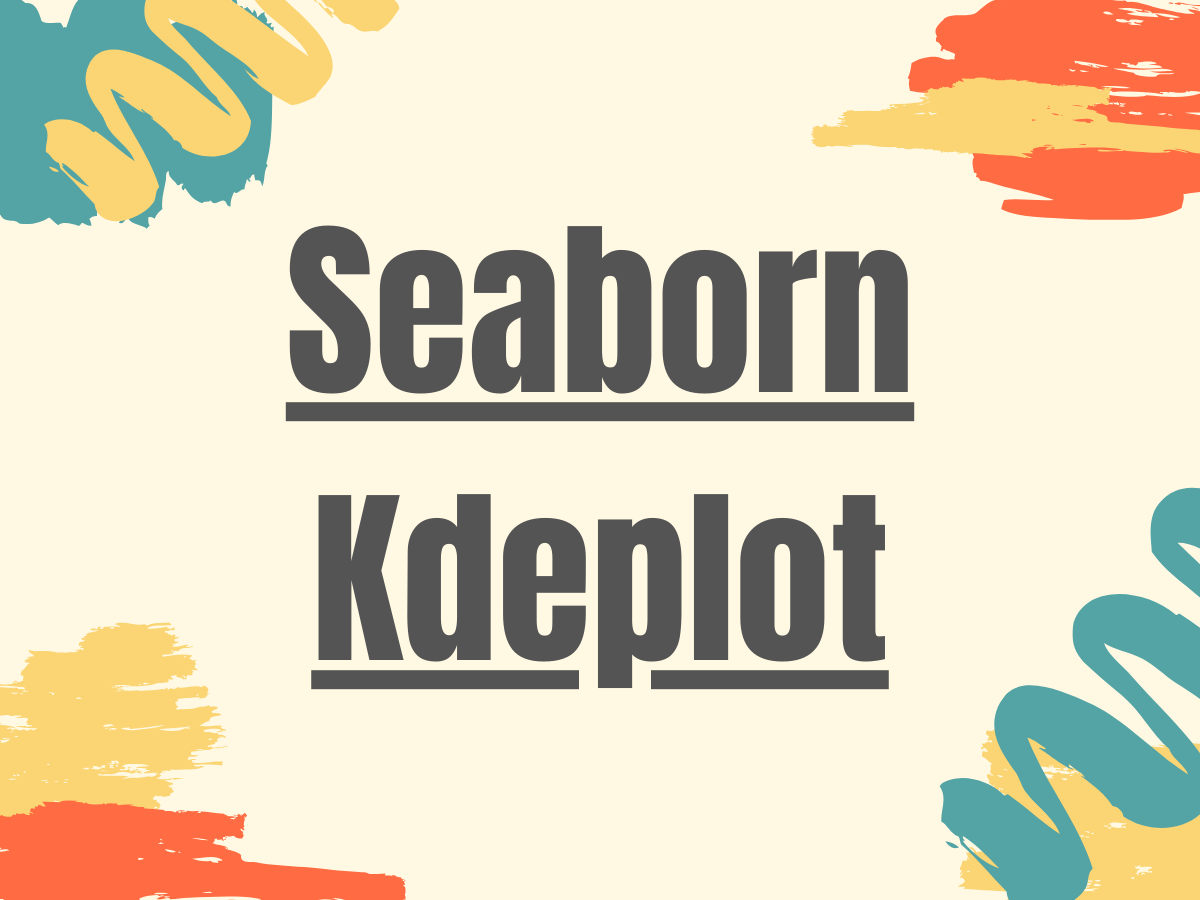- Log in to:
- Community
- DigitalOcean
- Sign up for:
- Community
- DigitalOcean
By Safa Mulani

Hey, folks! In our Seaborn tutorial, we will be focusing on Seaborn Kdeplot.
What is Kdeplot?
Kdeplot is a Kernel Distribution Estimation Plot which depicts the probability density function of the continuous or non-parametric data variables i.e. we can plot for the univariate or multiple variables altogether. Using the Python Seaborn module, we can build the Kdeplot with various functionality added to it.
In order to use the Seaborn module, we need to install and import the module using the below command:
pip install seaborn
import seaborn
Creating a Univariate Seaborn Kdeplot
The seaborn.kdeplot() function is used to plot the data against a single/univariate variable. It represents the probability distribution of the data values as the area under the plotted curve.
Syntax:
seaborn.kdeplot(data)
Example 1:
import seaborn as sn
import matplotlib.pyplot as plt
import numpy as np
data = np.random.randn(200)
res = sn.kdeplot(data)
plt.show()
In the above example, we have generated some random data values using the numpy.random.randn() function.
Output:

Example 2:
import seaborn as sn
import matplotlib.pyplot as plt
import numpy as np
data = np.random.randn(200)
res = sn.kdeplot(data,color='green',shade=True)
plt.show()
In the above example, we have highlighted the plot using the parameter - ‘shade’ to highlight the area under the curve. Further, we can set different colors to the plot using the parameter - ‘color’.
Output:

Creating a Bivariate Seaborn Kdeplot
Seaborn Kdeplots can even be used to plot the data against multiple data variables or bivariate(2) variables to depict the probability distribution of one with respect to the other values.
Syntax:
seaborn.kdeplot(x,y)
Thus, the distribution is represented as a contour plot depicting the relationship of the distribution between the two data variables.
Example:
import seaborn as sn
import matplotlib.pyplot as plt
import numpy as np
import pandas
data = pandas.read_csv("C:/mtcars.csv")
res = sn.kdeplot(data['mpg'],data['qsec'],color='blue',shade=True)
plt.show()
Output:

Plotting Seaborn Kdeplot along the Vertical axis
We can plot the Kdeplots along the y-axis using the below syntax:
Syntax:
seaborn.kdeplot(data,vertical=True)
Thus, by setting the ‘vertical’ parameter to True, we can plot the distribution against the y-axis.
Example:
import seaborn as sn
import matplotlib.pyplot as plt
import numpy as np
import pandas
data = pandas.read_csv("C:/mtcars.csv")
res = sn.kdeplot(data['mpg'],vertical=True,color='blue',shade=True)
plt.show()
Output:

Using color palettes within a Seaborn Kdeplot
Different color palettes can be used along with the Seaborn plots to visualize the data in a better manner using the ‘cmap’ parameter.
Different types of color palettes are available at Matplotlib Colormap.
Syntax:
seaborn.kdeplot(data,cmap)
Example:
import seaborn as sn
import matplotlib.pyplot as plt
import numpy as np
import pandas
data = pandas.read_csv("C:/mtcars.csv")
res = sn.kdeplot(data['mpg'],data['qsec'],shade=True,cmap="Purples_d")
plt.show()
Output:

Plotting two shaded Bivariate Kdeplots
The two shaded Bivariate Kdeplots help in understanding the variation of the data in terms of the probability distribution of the bivariate group of data variables.
Example:
import seaborn as sn
import matplotlib.pyplot as plt
import numpy as np
import pandas
data = pandas.read_csv("C:/mtcars.csv")
sn.set(style='dark',)
res = sn.kdeplot(data['hp'],data['cyl'],shade=True,cmap="Purples_d")
res = sn.kdeplot(data['hp'],data['cyl'],shade=True,cmap="Blues")
plt.show()
Output:

Addition of a Colorbar to a Seaborn Kdeplot
A colorbar maps the pictorial representation of values against the original data values and helps visualize the data in a better manner.
Syntax:
seaborn.kdeplot(data,cbar=True)
Example:
import seaborn as sn
import matplotlib.pyplot as plt
import numpy as np
import pandas
data = pandas.read_csv("C:/mtcars.csv")
sn.set(style='dark',)
res=sn.kdeplot(data['hp'],data['cyl'],shade=True,cmap="Purples_d",cbar=True)
plt.show()
Output:

Conclusion
Seaborn module is purely built upon the Matplotlib module and the combination is extensively used to visualize the data in different forms.
I would strongly recommend the readers to go through Python Matplotlib Tutorial for a better understanding about the basics of data visualization.
Thanks for learning with the DigitalOcean Community. Check out our offerings for compute, storage, networking, and managed databases.
About the author
Still looking for an answer?
- Table of contents
- What is Kdeplot?
- Creating a Univariate Seaborn Kdeplot
- Creating a Bivariate Seaborn Kdeplot
- Plotting Seaborn Kdeplot along the Vertical axis
- Using color palettes within a Seaborn Kdeplot
- Plotting two shaded Bivariate Kdeplots
- Addition of a Colorbar to a Seaborn Kdeplot
- Conclusion
- References
Deploy on DigitalOcean
Click below to sign up for DigitalOcean's virtual machines, Databases, and AIML products.
Become a contributor for community
Get paid to write technical tutorials and select a tech-focused charity to receive a matching donation.
DigitalOcean Documentation
Full documentation for every DigitalOcean product.
Resources for startups and SMBs
The Wave has everything you need to know about building a business, from raising funding to marketing your product.
Get our newsletter
Stay up to date by signing up for DigitalOcean’s Infrastructure as a Newsletter.
New accounts only. By submitting your email you agree to our Privacy Policy
The developer cloud
Scale up as you grow — whether you're running one virtual machine or ten thousand.
Get started for free
Sign up and get $200 in credit for your first 60 days with DigitalOcean.*
*This promotional offer applies to new accounts only.
